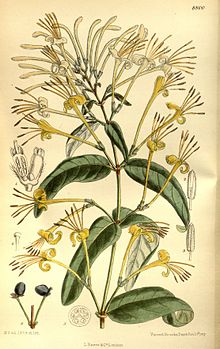Lonicera similis
| Lonicera similis | |
|---|---|

| |
| L. similis var. delavayi | |
| Scientific classification | |
| Kingdom: | Plantae |
| Clade: | Tracheophytes |
| Clade: | Angiosperms |
| Clade: | Eudicots |
| Clade: | Asterids |
| Order: | Dipsacales |
| Family: | Caprifoliaceae |
| Genus: | Lonicera |
| Species: | L. similis
|
| Binomial name | |
| Lonicera similis | |
| Synonyms | |
| |
Lonicera similis is a species of flowering plant in the family Caprifoliaceae, native to Western China.[3] This honeysuckle is known in cultivation by the variety delavayi (the Delavay honeysuckle) which is reported by some authorities to be synonymous with L. similis itself.[1] It is a large, twining, semi-evergreen shrub growing to 8 m (26 ft) tall by 1.5 m (4.9 ft) broad, with a profusion of fragrant tubular flowers opening white and ageing to yellow, in late summer and autumn. The flowers are followed by black berries. The Latin specific epithet similis means “similar to”.[4] It is similar in appearance to L. japonica, but larger and more robust.[5] The name delavayi honours the French missionary and botanist Père Jean Marie Delavay (1834-1895).[4]
Lonicera similis var. delavayi is hardy down to −15 °C (5 °F). It has gained the Royal Horticultural Society’s Award of Garden Merit.[6][7]
References[edit]
- ^ a b "Lonicera similis Hemsl". The Plant List. Retrieved 28 March 2018.
- ^ "Caprifoliaceae Lonicera similis Hemsl. ex F.B.Forbes & Hemsl". International Plant Names Index. Retrieved 28 March 2018.
- ^ "48. Lonicera similis Hemsley, J. Linn. Soc., Bot. 23: 366. 1888". Flora of China. Retrieved 28 March 2018.
- ^ a b Harrison, Lorraine (2012). RHS Latin for Gardeners. United Kingdom: Mitchell Beazley. ISBN 978-1845337315.
- ^ "Lonicera similis delavayi". Roseland House. Retrieved 28 March 2018.
- ^ "RHS Plantfinder - Lonicera similis var. delavayi". Retrieved 28 March 2018.
- ^ "AGM Plants - Ornamental" (PDF). Royal Horticultural Society. July 2017. p. 61. Retrieved 25 March 2018.
